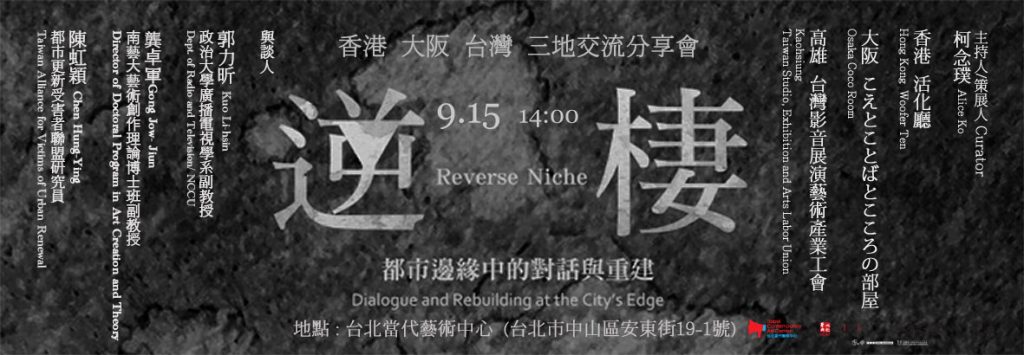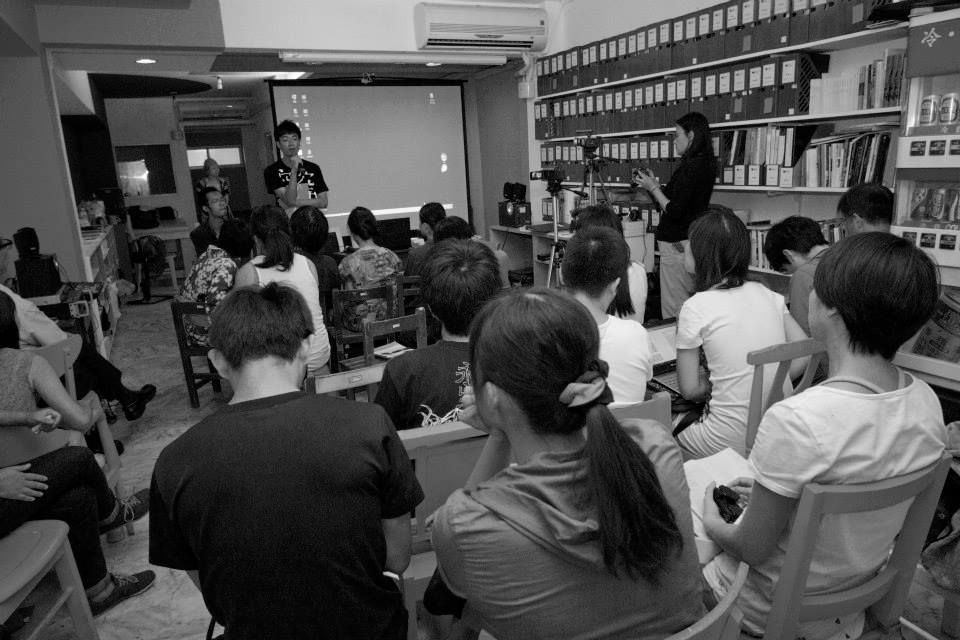(For English please scroll down)
(Speech in Chinese only)
09.15 逆棲-都市邊緣中的對話與重建 – 香港、日本大阪、與高雄三地交流分享會 2:30pm
09.15 Reverse Niche–Dialogue and Rebuilding at the City’s Edge 2:30pm
主持人/Host:
柯念璞 Alice Ko (策展人 Curator)
與談人/Speaker:
郭力昕 Kuo Li-hsin (政治大學廣播電視學系副教授Department of Radio and Television, Chengchi University, Taiwan)
龔卓軍 Gong Jow-Jiun (南藝大藝術創作理論博士班副教授Director of Doctoral Program in Art Creation and Theory )
陳虹穎 Chen Hung-Ying(都市更新受害者聯盟Taiwan Alliance for Victims of Urban Renewal)
對談藝術組織/Speaker:
香港/活化廳 Hong Kong/Woofer Ten
日本/大阪COCO ROOM Osaka/Coco room
高雄/台灣影音展演藝術產業工會Kaohsiung/ Taiwan Studio, Exhibition and Arts Labor Union
活動簡介
本座談會作為鳳甲美術館策展培力「逆棲-都市邊緣中的對話與重建(Reverse Niche – Dialogue and Rebuilding at the City’s Edge ) 香港 大阪與台灣三地聯展」的分享交流會。以 展覽內容為主題作延伸討論.在特定的都市發展脈絡下,這些藝術實踐作為溝通與連結的媒 介,藝術家設計何種對話框架誘引、邀請這些被排除,貧窮、少數、弱勢的城市文化參與, 並形成一種暫時性的公共領域。透過藝術作為一種開啟聯結的橋樑?以及社會公共議題如何 藉由藝術重新彰顯並且得以作為一種追尋進步的政治討論與實踐?
「逆」字作為迎向、迎擊之意,具有抵抗及革命意味。「棲」則作為動物安居巢穴之棲 居空間,在生物學中常以生態棲位(ecological niche),代表生物在環境中所佔據之地理空間 並賴以維生的基本生命單位;各生物種類依其生活習性,繁殖、衍化與活動,建構出自身生 命本質的生存空間。猶如人類為了生存而棲居於城市各個角落,因地置宜,生活就是在此時 此地生長出來的。在現代化的過程中,都市製造一種去除貧窮、創造資產累積的想像,許多 人移居城市尋求晉身中產階級的機會。然而都市發展主義的社會裡,視覺化的想像總是掩蓋 住都市長期存在的社會問題,排除、隔離、移民與貧窮人口的棲居之地。近年來則在都市規 劃與土地分區劃分的命運下,被公權力強制拆除建造綠地、大樓與商場,或放任讓其自生自 滅。這些被景觀(spectacle)所壟斷的都市處境,正隱含了將整體都市文化簡化為中產階級的 純粹敘事。
而當藝術與商業攜手合作彼此發揮淋漓盡致,藝術家開始試圖突破藝術與社會疏離內向 藝術創作,轉為一組積極實踐,朝向一個與公眾連結的藝術關係與過程。因此以「逆棲」做 為雙重意象的隱喻,不僅標誌現代城市發展下被排除的邊緣群體,一種兼具被拒斥在外的生 命處境與其形成的抵抗生存模式,同時也作為關注這些生命狀態的藝術行動者,強調以基地 發展一種長時間對話、參與式創作,來開啟有別於主流藝術生產的實踐。
儘管這些實踐時常理想多於現實,但是他們都指向對傳統的藝術生產以及資本主義社會 下的消費模式的對反。當左翼似乎已經從現實的政治中消失無蹤,在當代藝術的社會介入, 似乎呈現一種關注在如何讓計劃成為烏托邦想像,實驗特權階級的載體。此展覽以「逆棲 -都市邊緣中的對話與重建」為題,邀請來自香港、日本大阪與高雄三地城市的藝術組織。 分享與展示他們如何運用社群對話與基地式的藝術空間回應各自城市問題。
這來自三座城市的藝術組織在策展思考脈絡中各自代表不同的面相,或說是以一個藝術 實踐的過程去思考。從日本大阪こえとことばとこころの部屋對應日本高齡化社會孤獨死的 問題,因而希望構築起人與人之間的情感聯結。至台灣影音展演藝術產業工會進入高雄重工 業工廠包圍的大林蒲社區,面臨受汙染的生存環境藝術行動者與當地居民開啟對話的框架, 將組織居民抵抗其不公之現象。從相遇、組織與抵抗的過程,在香港活化廳則開展一種嘗試 將透過游擊式的抵抗運動透過藝術實踐將社會議題帶入社區的實驗,透過日常生活的長時間 碰撞,並試圖以諧擬戲謔、遊戲性的方法開啟公共領域,參與者以言說與行動討論出對城市 未來的想像。
「逆棲」同時指涉此種參與性/對話式藝術組織,以長時間/非物件化並深居社區的藝術實 踐成為主流之外的藝術生產。此類集體性藝術計畫比起藝術家個人創作,是較難進入市場 的。他們的實踐與其說作為「藝術作品」,更常以片斷化以社會事件、公共案例、工作坊或 表演來被理解與詮釋。此種面向社會關係與群眾的藝術實踐,在西方1990年代已經成為一股 普遍化,凝聚成計劃顛覆藝術物件、藝術家與觀眾之間傳統關係的慾望。而回到我們藝術生 產的生態來討論,公共資源分配貧乏與不穩定的文化政策下,這些組織如何經營與面對自身 勞動與藝術體系中的糾結情感。在幾個月的時間,訪問十幾位參與其中的藝術家.運用影像 紀錄他們如何思考自身所處的歷史與社會環境、都市空間以及他們所試圖對話的「社群」、 「人」等思考面向。
本展覽與交流也希望能作為歷史性計劃的起步,此類溝通性質的對話性作品急需對此類 創作進行一種紀錄、檔案整理的歷史性計畫。而這些藝術實踐被視為不斷發展或長期性的計 畫,並有著不確定的開始與結束。過去被視為觀看者與旁觀者,現在重新置位於共同生產者 與參與者。這參雜諸多複雜面向的藝術創作,我們無法再以照片或影像作為脫離現場最有說 服力的證據.而是必須開啓一種新的研究方法。
與談人簡介
香港/活化廳
隸屬於香港藝發局的上海街視藝中心在2009年,更名為活化廳。由一群關心社會、政治與公共議題的藝術家們所組織,重新思考藝術與社會、社群以及公共生活之間關係的如何創造、連結以及激發新類型的社群想像。面臨政治與經濟上交錯的困境。香港城市空間資本化不斷剝奪個人居住權,以及回歸後本土身分認同與政治上非自由的處境,活化廳的藝術家開啟另一種別於鬥爭現場的抵抗,以藝術與展演活動搭建起日常的公共討論平台,作一種長時間與居民對話的文化運動。香港自2005年反WTO運動以來,青年藝術家與社會運動者經過保皇后碼頭、反西九龍文化園區、反高鐵與菜園村運動等累積能量的展現於都市空間。面對香港城市文化逐漸走向企業管理的局勢,活化廳一方面回應藝術生產結構問題,同時構築多項關於反對市區強迫重建的藝術展覽。
日本/大阪COCO ROOM
在日本戰後經濟起步後,政府與企業攜手重建了現代化的都城,大批的現代式建築在土地上萌芽。如此龐大規模的建設背後所仰賴的臨時勞工全聚集在「寄せ場」1,臨時勞工在此等待「手配師」也就是仲介人員,每日招募港口或工地所需的勞動力,這種日雇工形成特殊的地理區域,在日本共有三處,東京的山谷、橫濱的壽町以及大阪的釜崎,而釜崎同時也是其中最大的臨時勞工聚落。1寄せ場為日本現代化過程中所產生的臨時勞工區域。而在日本最大臨時勞工聚集地大阪釜崎,於2007經營非營利藝術空間「COCOROOM」(「こえ」(聲音)、「ことば」(語言)與「こころ」(心))。這展現出藝術家在以貧窮、暴力的隔離之地,開啟對話的企圖。藝術在此地視為一種溝通的媒介,試圖連結被外界逐漸剝奪交流與溝通機會的勞工及流浪漢,創造出一個能彼此自由且無拘束地溝通交流的公共空間。運用詩、藝術邀請流浪漢、失業勞工、青少年以及婦女等弱勢族群的參與,在與藝術家敘述地方歷史與生命經驗,也產生一種對話關係,藝術家在對話的過程中建構了地方認知,同時在地的居民也在此過程建立自我認同。透過文學創作、詩詞、藝術活動重新認識這塊被汙名化與閒置隔離的區域背後的文化與生活故事。
高雄/台灣影音展演藝術產業工會
高雄大林蒲社區三面是臨海工業區的工廠所圍繞,一面是填海造陸的南星計畫,環境污染程度剝奪居民環境自主權力。台灣影音展演藝術產業工會先是從攝影班開始,一方面訓練社區居民使用影音工具,用來監督環境以及訴說自己的故事,另一方面也吸引年輕影音工作者與媒體,來認識城市,共同合作生產影片與報導,這些作品直指環境污染問題。活動過程也重新連結了部份在地青年跟原本不相往來社區團體,期待未來的行動能更有集體性。目前海馬小組的組成,包括紀錄片、藝術、劇場、電影等工作者,以及各種社會議題的行動者與學生。
EVENT
To “reverse” something implies engaging it with the intent to resist, and has connotations of revolution. While “niche” refers a space in which an animal can nest and take shelter. In the study of biology, the term “ecological niche” is often used to describe a geographical space and environment that an organism occupies and relies on for its sustenance. Organisms reproduce, diversify, and actively construct a space that is essential to personal survival. Similarly, humans construct their lives in various sections of a city to fulfill the necessities for their ways of life. Specific lifestyles evolve at a specific temporal and spatial nexus. As Lewis Mumford once described, a healthy city is composed of different neighborhoods. The unique appearance of these communities develops organically based on the needs of each community. From recreational facilities and spatial distribution, to commercial and non-commercial activities — all result from the living habits of its residents, while communal spaces are constructed from the interpersonal connections and interactions present in each community.
In the process of modernization, cities provide a fantasy that rejects poverty and creates material accumulation. People flock to cities in search of opportunities to join the ranks of the middle class. However, in a society governed by doctrines of urban development, this visual fantasy ultimately conceals long-standing urban social problems, as well as excludes and isolates the spaces inhabited by migrant and impoverished populations. In recent years, with their fate decided by urban planning and zoning, these spaces face being forcibly torn down by governments to build parks, high rises or marketplaces, or else are left to fend for their own survival. The urban contexts that have been monopolized by landscaping (spectacle) conceal the pure narrative that reduces the overall urban culture as one of middle class.
As mutual cooperation between art and commerce fully plays out, artists have begun to attempt inwardly focused artistic creations that are alienated from society; a transformation into a set of proactive and practical artistic relationships and processes of public connectivity. Hence, a “reverse niche” has a dual meaning, not only symbolizing the exclusion and resistance undertaken for survival by groups marginalized and disadvantaged in the process of urban development; but also highlighting the works created by art activists concerned with these living conditions that emphasize the development of a base for long-term dialogue and participatory creativity which will initiates an alternative practice of art production outside of the mainstream.
Focusing on the theme, “reversing the discourse and reconstruction of communities at the edge of cities,” this exhibition welcomes art organizations from Hong Kong, Osaka, and Kaohsiung to share how they shine a light on urban issues through community/dialogue/art space.The works exhibited by the art organizations from each of these three cities express a different type of physiognomy. The curating process itself is an artistic practice. Osaka’s Coco Room emphasizes interpersonal connections in response to Japan’s problem of neglected elders. In Taiwan, theTaiwan Studio, Exhibition and Arts Labor Union enters the Dalinpu Community to create a framework for discussion and organize local residents to fight against injustice. Woofer Ten of Hong Kong raises levels of awareness regarding social issues by introducing art into the daily lives of local residents. After such mobilization and resistance, how should we communicate and take action in the public domain to initiate a discussion about the future of our cities?
The metaphor of a “habitat reversal” also refers to a participatory/dialogic art organization. Artistic practices that have been deeply involved in communities for a long time with a non-object orientation have led to the creation of art that lies outside the mainstream. With the uneven and irregular distribution of resources to a contemporary art environment under unsound cultural policies, how can these organizations operate and respond to their ecology? The art traditions of British communities, and the experimental experiences of American temporary public art, the originally inward criticisms of art works are converted into an active practice. From the wall of an art gallery, they directly face the world, combining new forms and social movements amidst the interaction of subjects. However, this type of communicative and dialogic work often leaves behind traces due to its nature. And, as a result, there is urgent need for a historic plan that records and comprehensively files this type of art work.
ABOUT PARTICIPATOR
Hong Kong/Woofer Ten
In 2009, the Shanghai Street Art Center of the Hong Kong Arts Development Council changed its name to Woofer Ten. It was organized by a group of artists concerned with social, political and public issues, in order to rethink the relationship between art and society, community and public life, and to create, connect and catalyze a new community imagination. They were faced with a confluence of political and economic obstacles: the capitalization of urban spaces continue to deprive individual rights to shelter; while the process of reunification had taken away freedom to express local identity and politics. The artists of Woofer Ten opened up another type of resistance that is removed from the site of conflict, and constructed an everyday platform for discussion using art and exhibition activities to provide a longer term cultural movement with the public.
Osaka/Coco room
The non-profit art space “Cocoroom” (こえ (sound), ことば (language) and こころ (heart)) was established in 2007 in Kamagasaki, Osaka – the location of the largest community of temporary laborers in Japan. This demonstrated the artists’ intention to begin dialogue in a space removed from poverty and violence. Here, art is perceived as a communications medium that connects with laborers and the homeless who have been gradually deprived of opportunities to interact and communicate with the world-at-large. A public space where they can communicate and interact freely without inhibitions has been created. Disenfranchised groups including the homeless, unemployed laborers, youth, and women, all participate through art and poetry. This process of describing the local history and life experiences with the artists creates a relationship of dialogue.This dialogue enables artists to construct a local identity, while area residents also establish a selfidentity in the same process. The cultural and life stories of this stigmatized and alienated region are rediscovered trough literary compositions, poetry, and artistic activities.
Kaohsiung/ Taiwan Studio, Exhibition and Arts Labor Union
As the largest city in Southern Taiwan, Kaohsiung has replicated the urban development of Taipei in recent years. Pollution caused by industrial factories have been demolished or covered up in the name of arts and culture. Kaohsiung’s Dalinpu District is surrounded on three sides by factories of the coastal industrial zone. On one side is the land-reclamation South Star Plan whose environmental pollution has deprived area residents of their environmental autonomy. The Taiwan Studio, Exhibition and Arts Labor Union began with photography classes which not only trained area residents to use recording tools to monitor the environment and to tell their own stories, but also attracted a number of young video artists and the media to the area to learn, to produce films and to report. Many of these works directly address the environmental pollution issue. In the process of this activity, they have connected previously disparate groups of local youth with community groups. It is hoped that future actions will be even more collective. At the moment the Seahorse Team has been assembled and includes those who work with documentary, art, theatre and film as well as social activists and students.
活動紀錄
PHOTO/柯念璞提供
TEXT/賴佳翎
此分享會是以「逆棲-都市邊緣中的對話與重建(Reverse Niche – Dialogue and Rebuilding at the City’s Edge ) 香港、大阪與台灣三地聯展」的展覽內容為主題作延伸討論。藝術家分享他們如何透過跨域合作,邀請在特定的都市發展脈絡下被排除在外的城市與相對弱勢的一群,共同參與在地的文化創作,並從各式各樣被設計出的對話過程逐漸形塑成一個自發性的公共場域。
COCO ROOM
COCO ROOM是間深埋在大阪釜崎街道的公共空間,具有咖啡廳、展示空間、資訊中心、居民閒聊傾吐心聲等多元功能。創辦人上田假奈代小姐不斷構思如何轉變被孤立的釜崎社區給大眾產生恐懼或髒亂、危險的印象,從一開始透過文學與當地居民的對話,讓原本冷漠疏離的人際關係藉由藝術創作再次地搭起無拘束的溝通橋樑。同時她也積極地連結各領域的專家參與藝術計畫,經由口語交談與紀錄,接著讓藝術家透過不同的表現手法再現居民的生命經驗,以及如何與地方交互影響的關係。
上田小姐認為藝術提供了一個很安全的空間,能夠讓人們很自在地說自己的話。既然活著就是一種表現,那麼COCO ROOM便是藉著重新建立關係與創造可能性協助人們能夠思考他們想要如何活著。
活化廳
香港「活化廳」是一個由十多位本地文化藝術工作者共同營運的藝術組織,期望以持續性的對話建立一個「藝術/社區」彼此活化的平台。藉著不同主題的藝術計劃,引起人們對藝術、生活、社區、政治和文化的思考和討論,亦藉以打通社區豐富的人情脈絡,帶動彼此的參與、分享和發現,勾勒一小社區鄰里生活模式可能。「活化廳」創辦人認為其實以前就有這種街坊對話空間,但在工業化空間下疏離的關係讓「人情味」的記憶逐漸消逝,我們現在卻諷刺地要重新打造一個對話空間。而他也相當重視如何讓計畫持續下去的問題,像是經濟收入來源以及如何維持逆棲的生命狀態。
台灣影音展演藝術產業工會-大林蒲
在探討藝術介入公共空間如何可能,須先對藝術的公共性進行討論與想像,包括如何使用意見空間、如何詮釋和展現基本價值,並如何盡可能地使用簡潔的語言回應人與空間的關係。介紹大林蒲之前,倪翔為現場觀眾帶來歌曲創作,以諧諷口吻呈現出事件本質的荒謬性,並讓歡樂的氣氛帶動與參與者的連結,另外像是惡搞TED的紀錄片也同樣是以荒誕的形式去談論一般認為嚴肅的議題,或許這是一種反抗的美學。
我們有支持與討論的必要,即便是「少數」,仍然有針對基本價值討論的重要性。從「逆棲」看意見空間如何被打造、如何促成溝通和交流,並且如何持續實踐,不僅動搖許多過去對都更的既有想像,也給予大眾重新思索與理解問題的可能性。
更多照片:https://www.facebook.com/media/set/?set=a.10152100967314878.1073741868.361110184877&type=3



